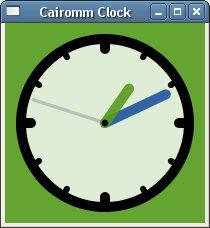| Example Application: Creating a Clock with Cairo | ||
|---|---|---|
|
|
Chapter 17. The Drawing Area Widget | |
Now that we've covered the basics of drawing with Cairo, let's try to
put it all together and create a simple application that actually
does something. The following example uses Cairo to create a custom
Clock widget. The clock has a second hand, a
minute hand, and an hour hand, and updates itself every second.

File: clock.h (For use with gtkmm 3, not gtkmm 2)
#ifndef GTKMM_EXAMPLE_CLOCK_H
#define GTKMM_EXAMPLE_CLOCK_H
#include <gtkmm/drawingarea.h>
class Clock : public Gtk::DrawingArea
{
public:
Clock();
virtual ~Clock();
protected:
//Override default signal handler:
bool on_draw(const Cairo::RefPtr<Cairo::Context>& cr) override;
bool on_timeout();
double m_radius;
double m_line_width;
};
#endif // GTKMM_EXAMPLE_CLOCK_H
File: clock.cc (For use with gtkmm 3, not gtkmm 2)
#include <ctime>
#include <cmath>
#include <cairomm/context.h>
#include <glibmm/main.h>
#include "clock.h"
Clock::Clock()
: m_radius(0.42), m_line_width(0.05)
{
Glib::signal_timeout().connect( sigc::mem_fun(*this, &Clock::on_timeout), 1000 );
}
Clock::~Clock()
{
}
bool Clock::on_draw(const Cairo::RefPtr<Cairo::Context>& cr)
{
Gtk::Allocation allocation = get_allocation();
const int width = allocation.get_width();
const int height = allocation.get_height();
// scale to unit square and translate (0, 0) to be (0.5, 0.5), i.e.
// the center of the window
cr->scale(width, height);
cr->translate(0.5, 0.5);
cr->set_line_width(m_line_width);
cr->save();
cr->set_source_rgba(0.337, 0.612, 0.117, 0.9); // green
cr->paint();
cr->restore();
cr->arc(0, 0, m_radius, 0, 2 * M_PI);
cr->save();
cr->set_source_rgba(1.0, 1.0, 1.0, 0.8);
cr->fill_preserve();
cr->restore();
cr->stroke_preserve();
cr->clip();
//clock ticks
for (int i = 0; i < 12; i++)
{
double inset = 0.05;
cr->save();
cr->set_line_cap(Cairo::LINE_CAP_ROUND);
if(i % 3 != 0)
{
inset *= 0.8;
cr->set_line_width(0.03);
}
cr->move_to(
(m_radius - inset) * cos (i * M_PI / 6),
(m_radius - inset) * sin (i * M_PI / 6));
cr->line_to (
m_radius * cos (i * M_PI / 6),
m_radius * sin (i * M_PI / 6));
cr->stroke();
cr->restore(); /* stack-pen-size */
}
// store the current time
time_t rawtime;
time(&rawtime);
struct tm * timeinfo = localtime (&rawtime);
// compute the angles of the indicators of our clock
double minutes = timeinfo->tm_min * M_PI / 30;
double hours = timeinfo->tm_hour * M_PI / 6;
double seconds= timeinfo->tm_sec * M_PI / 30;
cr->save();
cr->set_line_cap(Cairo::LINE_CAP_ROUND);
// draw the seconds hand
cr->save();
cr->set_line_width(m_line_width / 3);
cr->set_source_rgba(0.7, 0.7, 0.7, 0.8); // gray
cr->move_to(0, 0);
cr->line_to(sin(seconds) * (m_radius * 0.9),
-cos(seconds) * (m_radius * 0.9));
cr->stroke();
cr->restore();
// draw the minutes hand
cr->set_source_rgba(0.117, 0.337, 0.612, 0.9); // blue
cr->move_to(0, 0);
cr->line_to(sin(minutes + seconds / 60) * (m_radius * 0.8),
-cos(minutes + seconds / 60) * (m_radius * 0.8));
cr->stroke();
// draw the hours hand
cr->set_source_rgba(0.337, 0.612, 0.117, 0.9); // green
cr->move_to(0, 0);
cr->line_to(sin(hours + minutes / 12.0) * (m_radius * 0.5),
-cos(hours + minutes / 12.0) * (m_radius * 0.5));
cr->stroke();
cr->restore();
// draw a little dot in the middle
cr->arc(0, 0, m_line_width / 3.0, 0, 2 * M_PI);
cr->fill();
return true;
}
bool Clock::on_timeout()
{
// force our program to redraw the entire clock.
auto win = get_window();
if (win)
{
Gdk::Rectangle r(0, 0, get_allocation().get_width(),
get_allocation().get_height());
win->invalidate_rect(r, false);
}
return true;
}
File: main.cc (For use with gtkmm 3, not gtkmm 2)
#include "clock.h"
#include <gtkmm/application.h>
#include <gtkmm/window.h>
int main(int argc, char** argv)
{
auto app = Gtk::Application::create(argc, argv, "org.gtkmm.example");
Gtk::Window win;
win.set_title("Cairomm Clock");
Clock c;
win.add(c);
c.show();
return app->run(win);
}
As before, almost all of the interesting stuff is done in the draw
signal handler on_draw(). Before we dig
into the draw signal handler, notice that the constructor for the
Clock widget connects a handler function
on_timeout() to a timer with a timeout
period of 1000 milliseconds (1 second). This means that
on_timeout() will get called once per
second. The sole responsibility of this function is to invalidate
the window so that gtkmm will be forced to redraw it.
Now let's take a look at the code that performs the actual drawing.
The first section of on_draw() should be
pretty familiar by now. This example again scales the coordinate system
to be a unit square so that it's easier to draw the clock as a
percentage of window size so that it will automatically scale when
the window size is adjusted. Furthermore, the coordinate system is
scaled over and down so that the (0, 0) coordinate is in the very
center of the window.
The function Cairo::Context::paint() is used here
to set the background color of the window. This function takes no
arguments and fills the current surface (or the clipped portion of
the surface) with the source color currently active. After setting
the background color of the window, we draw a circle for the clock
outline, fill it with white, and then stroke the outline in black.
Notice that both of these actions use the
_preserve variant to preserve the current path,
and then this same path is clipped to make sure that our next lines
don't go outside the outline of the clock.
After drawing the outline, we go around the clock and draw ticks for every hour, with a larger tick at 12, 3, 6, and 9. Now we're finally ready to implement the time-keeping functionality of the clock, which simply involves getting the current values for hours, minutes and seconds, and drawing the hands at the correct angles.